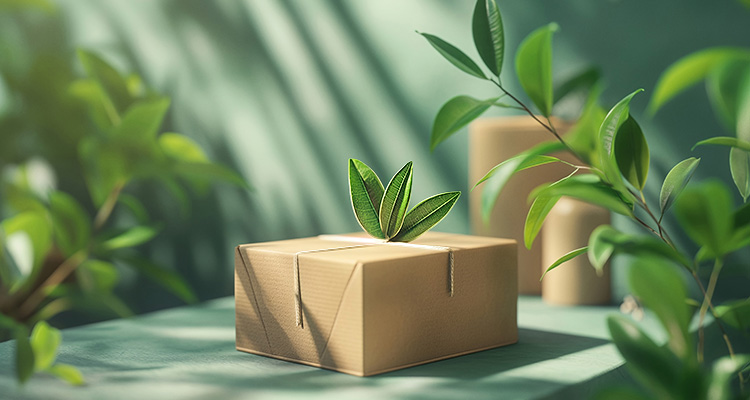Balancing sustainability and effectiveness.
As we enter the second half of 2024, the packaging industry is amid a redefining era, driven by escalating demands for sustainability and efficiency. This year, particularly on the eve of the Packaging and Packaging Waste Regulation’s (PPWR) implementation in Europe, packaging materials are under an increasingly bright spotlight.
Thankfully, practices across the industry are keeping pace with change, innovating lighter, stronger materials that allow brand owners to satisfy consumer demands, meet ever-changing regulations and maximize sustainability efforts, all at the same time.
Constant change
Achieving material efficiency requires continuous innovation, looking to rework and revisit the ways in which we utilize existing materials and how we combine

them with new ones.
The PPWR aims to push this forward, mandating a range of tactics to reduce empty space and volume to tackle unnecessary waste head-on. Beyond just cutting down on waste the regulation introduces labelling requirements to support recycling efforts and sets ambitious targets for reuse.
For brand owners and packaging manufacturers alike, this means a dual focus on compliance and innovation, finding new ways to fit existing needs.
Consumer-driven
In recent years, consumers too have become increasingly concerned about the effects of packaging waste, making sustainability not only a regulatory concern, but a reputational one. In fact, more than half of consumers place recycling at the top of the list to reduce the impacts of climate change. Thereby increasing the onus on brand owners to ensure their packaging meets their consumers’ demands, or risk being left behind.
But in reality, consumer demands don’t always ring true. For example, despite growing numbers (55 percent) saying they’ll pay more for more sustainable products, in the face of a continued cost of living crisis, the industry isn’t always seeing this translate into sales. On the reusable front, almost a quarter of consumers agree that it would take too much effort to return packaging to the point of purchase, leaving retailers questioning the validity of their schemes.
It’s clear then, alongside a perception of doing better by the environment, cost and convenience are crucial for consumers, with many considering them a necessity rather than a luxury. So, brand owners have a tricky line to walk, finding a balance between the latest innovations in packaging materials while ensuring these changes don’t feel too radical for their customers, helping them to make greener choices with little extra thought.
Doing more with less
The continuing industry pivot towards lightweighting has set a new standard for packaging material, putting an emphasis on resource efficiency without compromising material effectiveness. As well as meeting environmental regulations, lightweighting also brings with it several benefits. Allowing brand owners to reap economic rewards by getting the most out of all materials used, while reaffirming their commitment to sustainability, making a significant impact on waste reduction and resource conservation.
 Emerging renewable materials, such as microfibrillated cellulose (MFC) are already contributing to these increasing demands. MFC is a 100 percent renewable wood fiber-based material that can be used to strengthen fiber-based packaging materials to increase durability without significantly increasing weight.
Emerging renewable materials, such as microfibrillated cellulose (MFC) are already contributing to these increasing demands. MFC is a 100 percent renewable wood fiber-based material that can be used to strengthen fiber-based packaging materials to increase durability without significantly increasing weight.
And, standing at the forefront of environmental trends, Stora Enso was the first company to successfully launch a commercial paperboard packaging material including MFC almost a decade ago. By pushing the boundaries of what’s possible, today packaging material that incorporates MFC minimizes material thickness while maximizing performance.
Since 2015, MFC has been redefining packaging material capabilities, but now’s not the time to rest on our laurels.
Looking forward
The packaging horizon is filled with potential. Further advances in material science, particularly in materials based on renewable sources, will offer unprecedented functionality, ensuring no brand owner or consumer must pick between sustainability and performance.
As we look to the next six months and beyond, the packaging industry is set to not just adapt, but lead in sustainability and innovation. This exciting phase in the packaging industry promises to meet current market demands and anticipate future trends, positioning renewable and technologically advanced packaging materials at the forefront of consumer preferences.
For a list of the sources used in this article, please contact the editor.
By Tuomas Puonti
Tuomas Puonti is VP of Product and Portfolio Development at Stora Enso, Packaging Materials. Part of the global bioeconomy, Stora Enso is a leading provider of renewable products in packaging, biomaterials and wooden construction, and one of the largest private forest owners in the world. It believes that everything that is made from fossil-based materials today can be made from a tree tomorrow.
